Abstract
Six pigeons responded on two concurrently available keys that defined patches with the following characteristics. Reinforcer stores repleted on a patch as a linear function of time when the bird had last responded to the other patch, or else did not replete. Repletion schedules thus timed only when the bird was absent from the patch. Reinforcer stores on a patch could be depleted and reinforcers obtained, again as a linear function of time, when the bird responded on a key. Depletion schedules thus timed only when the birds were present at a patch. Experiment 1 investigated changing relative depletion rates when repletion rates were constant and equal (Part 1) and changing relative repletion rates when the depletion rates were constant and equal (Part 2). Response- and time-allocation ratios conformed to a generalized matching relation with obtained reinforcer ratios, and there appeared to be no control by the size of the reinforcer stores. In Experiment 2, absolute depletion rates were varied with a pair of unequal repletion rates (Part 3), and absolute repletion rates were varied with a pair of unequal depletion rates (Part 4). Dwell times in the patches were not affected by either variation. Melioration theory predicted the results of Experiment 1 quite closely but erroneously predicted changing dwell times in Experiment 2. Molar maximization theory did not accurately predict the results of either experiment.
Keywords: concurrent schedules, patches, repletion, depletion, choice, generalized matching, pecking, pigeons
Full text
PDF
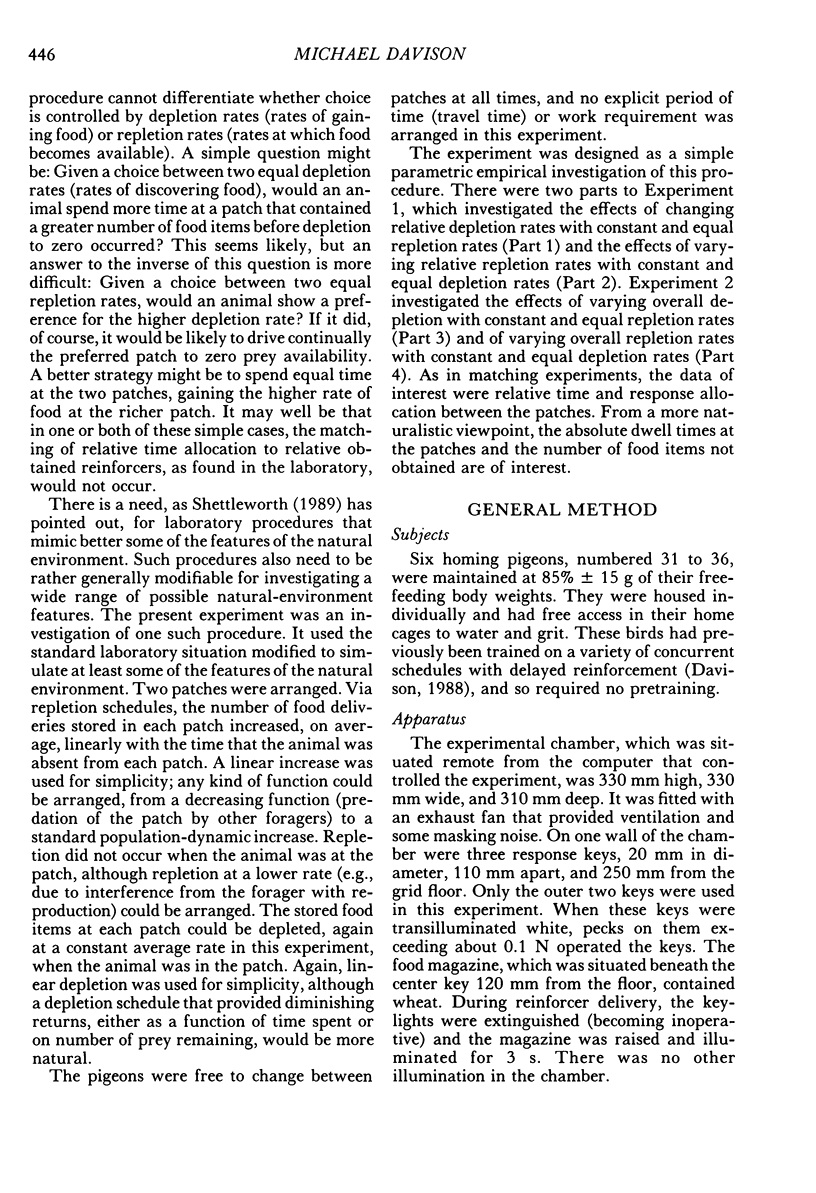

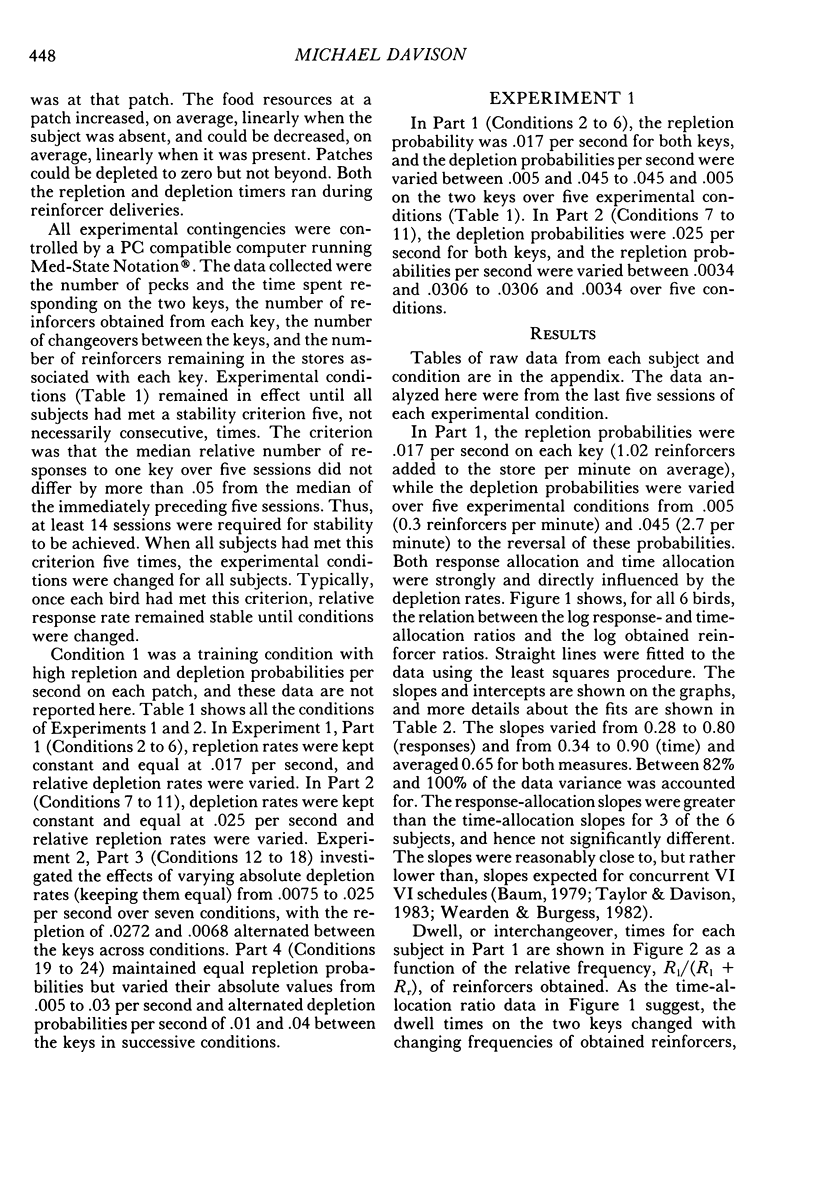

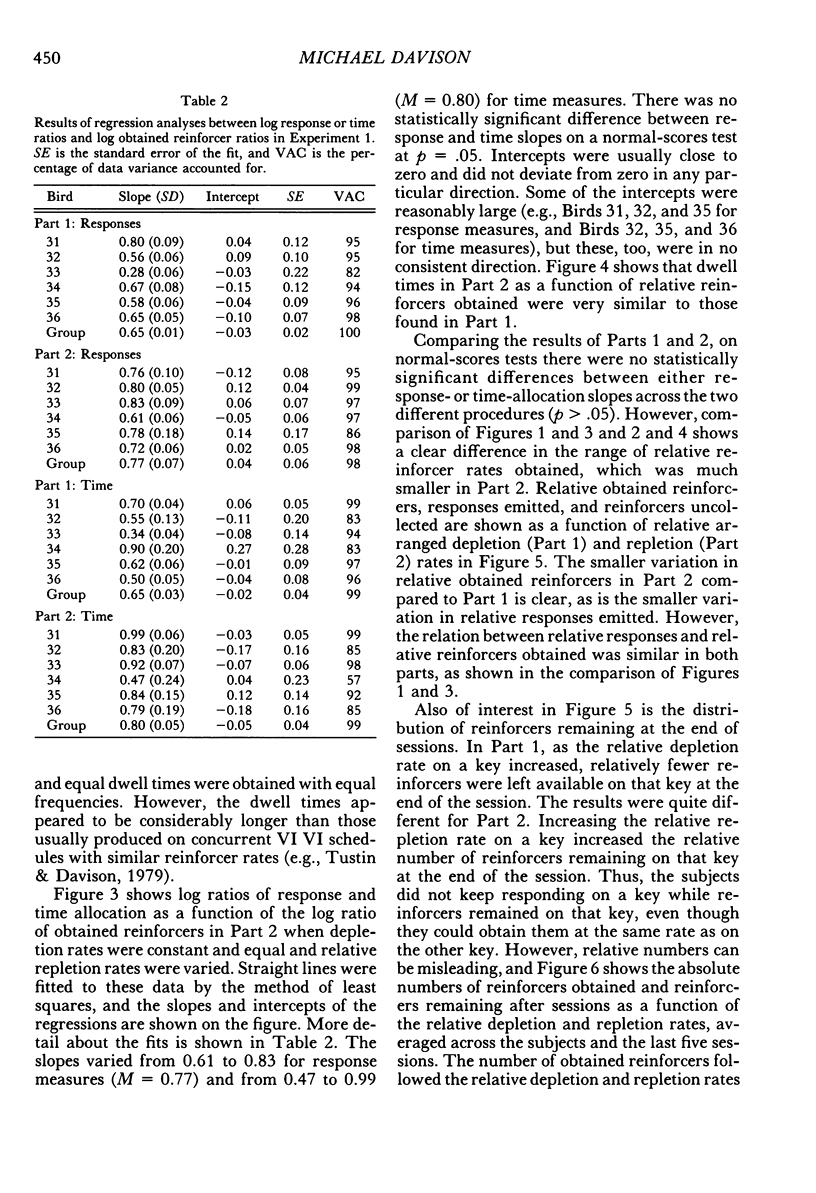







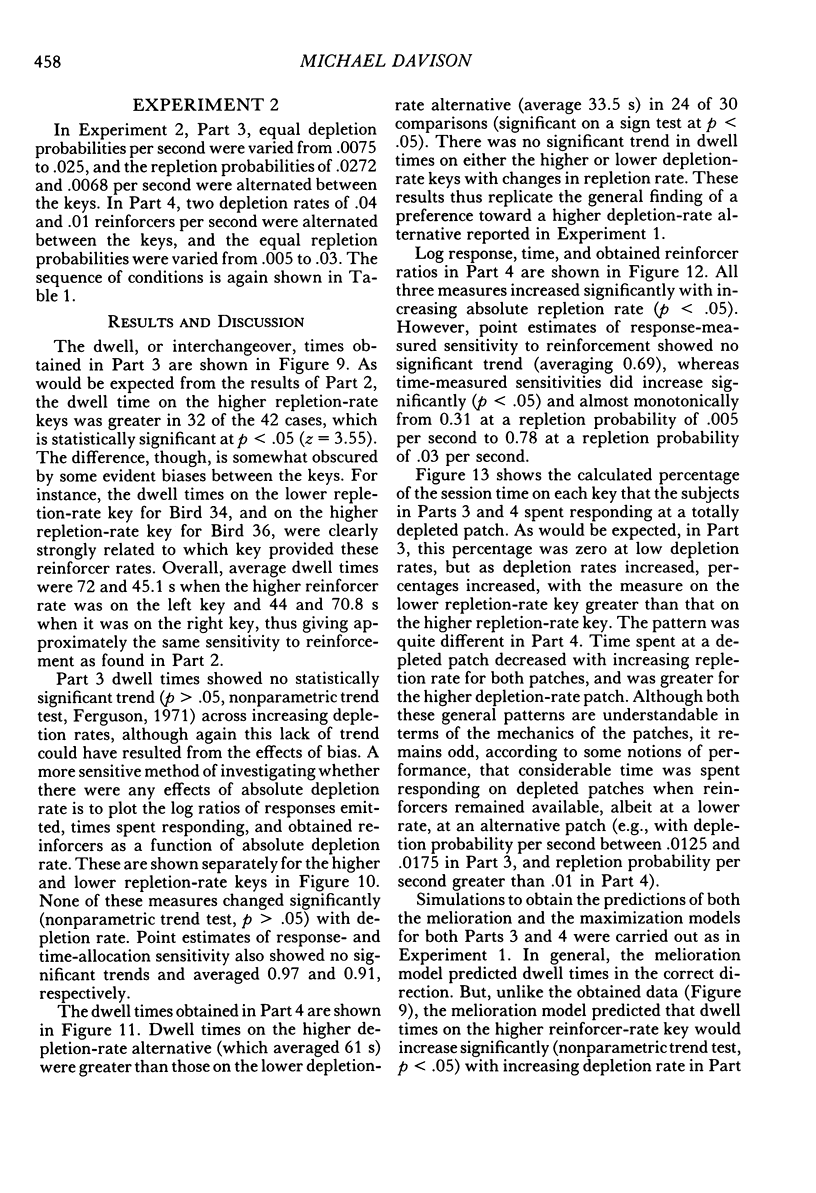





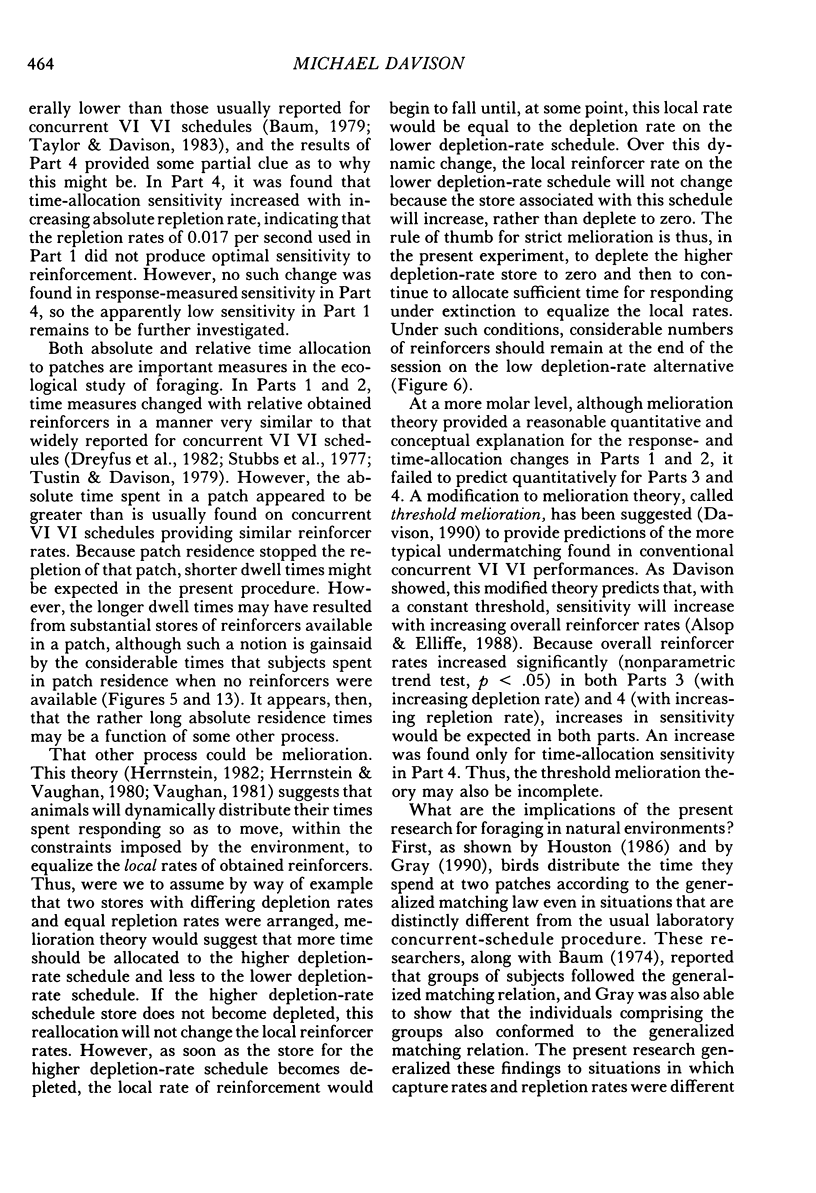





Selected References
These references are in PubMed. This may not be the complete list of references from this article.
- Alsop B., Elliffe D. Concurrent-schedule performance: Effects of relative and overall reinforcer rate. J Exp Anal Behav. 1988 Jan;49(1):21–36. doi: 10.1901/jeab.1988.49-21. [DOI] [PMC free article] [PubMed] [Google Scholar]
- Baum W. M. Choice in free-ranging wild pigeons. Science. 1974 Jul 5;185(4145):78–79. doi: 10.1126/science.185.4145.78. [DOI] [PubMed] [Google Scholar]
- Baum W. M. Matching, undermatching, and overmatching in studies of choice. J Exp Anal Behav. 1979 Sep;32(2):269–281. doi: 10.1901/jeab.1979.32-269. [DOI] [PMC free article] [PubMed] [Google Scholar]
- Davison M. Concurrent schedules: Interaction of reinforcer frequency and reinforcer duration. J Exp Anal Behav. 1988 May;49(3):339–349. doi: 10.1901/jeab.1988.49-339. [DOI] [PMC free article] [PubMed] [Google Scholar]
- Dreyfus L. R., Dorman L. G., Fetterman J. G., Stubbs D. A. An invariant relation between changing over and reinforcement. J Exp Anal Behav. 1982 Nov;38(3):327–338. doi: 10.1901/jeab.1982.38-327. [DOI] [PMC free article] [PubMed] [Google Scholar]
- Herrnstein R. J., Loveland D. H. Maximizing and matching on concurrent ratio schedules. J Exp Anal Behav. 1975 Jul;24(1):107–116. doi: 10.1901/jeab.1975.24-107. [DOI] [PMC free article] [PubMed] [Google Scholar]
- Houston A. The matching law applies to wagtails' foraging in the wild. J Exp Anal Behav. 1986 Jan;45(1):15–18. doi: 10.1901/jeab.1986.45-15. [DOI] [PMC free article] [PubMed] [Google Scholar]
- Hunter I. W., Davison M. C. Response rate and changeover performance on concurrent variable-interval schedules. J Exp Anal Behav. 1978 May;29(3):535–556. doi: 10.1901/jeab.1978.29-535. [DOI] [PMC free article] [PubMed] [Google Scholar]
- Lobb B., Davison M. C. Performance in concurrent interval schedules: a systematic replication. J Exp Anal Behav. 1975 Sep;24(2):191–197. doi: 10.1901/jeab.1975.24-191. [DOI] [PMC free article] [PubMed] [Google Scholar]
- Stubbs D. A., Pliskoff S. S., Reid H. M. Concurrent schedules: a quantitative relation between changeover behavior and its consequences. J Exp Anal Behav. 1977 Jan;27(1):85–96. doi: 10.1901/jeab.1977.27-85. [DOI] [PMC free article] [PubMed] [Google Scholar]
- Taylor R., Davison M. Sensitivity to reinforcement in concurrent arithmetic and exponential schedules. J Exp Anal Behav. 1983 Jan;39(1):191–198. doi: 10.1901/jeab.1983.39-191. [DOI] [PMC free article] [PubMed] [Google Scholar]
- Tustin R. D., Davison M. Choice: Effects of changeover schedules on concurrent performance. J Exp Anal Behav. 1979 Jul;32(1):75–91. doi: 10.1901/jeab.1979.32-75. [DOI] [PMC free article] [PubMed] [Google Scholar]
- Vaughan W. Melioration, matching, and maximization. J Exp Anal Behav. 1981 Sep;36(2):141–149. doi: 10.1901/jeab.1981.36-141. [DOI] [PMC free article] [PubMed] [Google Scholar]
- Wearden J. H., Burgess I. S. Matching since Baum (1979). J Exp Anal Behav. 1982 Nov;38(3):339–348. doi: 10.1901/jeab.1982.38-339. [DOI] [PMC free article] [PubMed] [Google Scholar]


